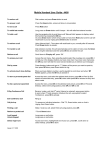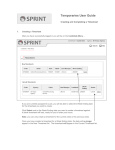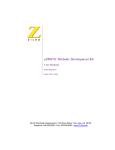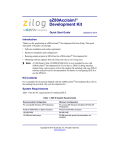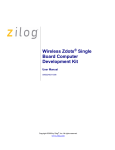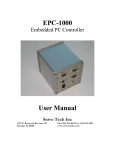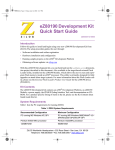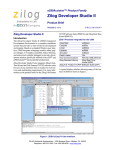Download Application Note: ZDS II for eZ80Acclaim!: Calling C
Transcript
Application Note
ZDS II for eZ80Acclaim!: Calling C
Functions from Assembly and
Vice Versa
AN033301-0711
Abstract
In certain situations, developers find that they must combine source code files written in
Assembly code into C routines; the reverse is often also true. This application note aims to
provide a straightforward method for combining Assembly routines and C language routines into one project in ZDS II, and discusses how ZDS II allocates arguments into the
stack for parameter passing and where return values are stored. A discussion about naming
conventions for functions used by ZDS II is also covered.
Discussion
The eZ80Acclaim! C-Compiler is a conforming freestanding 1989 ANSI C implementation with some exceptions.1 In accordance with the definition of a freestanding implementation, the compiler accepts programs that confine the use of the features of the ANSI
standard library to the contents of the standard headers <float.h>, <limits.h>,
<stdarg.h> and <stddef.h>. The eZ80Acclaim! compiler release supports more of the
standard library than is required of a freestanding implementation, as listed in the RunTime Library section of the Zilog Developer Studio II – eZ80Acclaim! User Manual
(UM0144).
The eZ80Acclaim! C-Compiler supports language extensions for the easy programming of
the eZ80Acclaim! processor architecture. The language extensions are described in the
Language Extensions section of the Zilog Developer Studio II – eZ80Acclaim! User Manual (UM0144).
The following sections describe the features of the eZ80Acclaim! C-Compiler:
•
Calling Conventions – see page 1
•
Calling Assembly Functions from C – see page 5
•
Calling C Functions from Assembly – see page 7
The eZ80Acclaim! C-Compiler is optimized for embedded applications in which execution speed and code size are crucial.
Calling Conventions
The C-Compiler imposes a strict set of rules on function calls. Except for special run-time
support functions, any function that calls or is called by a C function must follow these
1. These exceptions are described in the ANSI Standard Compliance chapter of the Zilog Developer Studio II – eZ80Acclaim! User
Manual (UM0144).
AN033301-0711
Page 1 of 13
ZDS II for eZ80Acclaim!: Calling C Functions from Assembly and Vice Versa
Application Note
rules. Failure to adhere to these rules can disrupt the C environment and cause a C program to fail.
The following sections describe the calling conventions:
•
Function Call Mechanism
•
Special Cases
Function Call Mechanism
A (caller) function performs the following tasks when it calls another (called) function:
1. Save all registers (other than the return value register, to be defined below) that might
be needed in the caller function after the return from the call, that is, a "caller save"
mechanism is used. The registers are saved by pushing them on the stack before the
call.
2. Push all function parameters on the stack in reverse order (the rightmost declared
argument is pushed first, and the leftmost is pushed last). This places the leftmost
argument on top of the stack when the function is called. For a varargs function, all
parameters are pushed on the stack in reverse order.
3. Call the function. The call instruction pushes the return address on the top of the stack.
4. On return from the called function, caller pops the arguments off the stack or
increments the stack pointer.
5. The caller then restores the saved registers by popping them from the stack.
6. The following example illustrates what must be done in an assembly procedure that
calls a C function, including "caller save" of the BC register:
LD BC,123456h ; BC is used across function call
PUSH BC
; Must be pushed before arguments are pushed
PUSH HL
; Push argument
CALL _foo
; Might modify
BC POP BC
; Remove argument
POP BC
; Must be popped after arguments are deallocated
ADD HL,BC
; Wrong value of BC could be used if BC not
; saved by caller
In the eZ80® MPU, a multiple of 3 bytes is always used when pushing arguments onto the
stack. Table 1 shows how differing types of arguments are passed.
Table 1. Arguments of Differing Type
AN033301-0711
Type
Size
Memory (Low to High)
char
3 bytes
xx ?? ??
short
3 bytes
xx xx ??
int
3 bytes
xx xx xx
Page 2 of 13
ZDS II for eZ80Acclaim!: Calling C Functions from Assembly and Vice Versa
Application Note
Table 1. Arguments of Differing Type (Continued)
Type
Size
Memory (Low to High)
long
6 bytes
xx xx xx xx ?? ??
float
6 bytes
xx xx xx xx ?? ??
double
6 bytes
xx xx xx xx ?? ??
pointer
3 bytes
xx xx xx
The called function performs the following tasks:
1. Push the frame pointer (i.e., the IX Register) onto the stack and allocate the local
frame:
– Set the frame pointer to the current value of the stack pointer
– Decrement the stack pointer by the size of locals and temporaries, if required
2. Execute the code for the function.
3. If the function returns a scalar value, place it in the appropriate register, as defined in
Table 2. For functions returning an aggregate value, see the Special Cases section on
page 4.
4. Deallocate the local frame (i.e., set the stack pointer to the current value of the frame
pointer) and restore the Frame Pointer Register (IX) from the stack.
5. Return.
Table 2 specifies how scalar values – those other than structs or unions – are returned.
Table 2. Arguments of Differing Type
Type
Register
Register Contents: Most
to Least Significant
char
A
xx
short
HL
?? xx xx
int
HL
xx xx xx
long
E:HL
xx: xx xx xx
float
E:HL
xx: xx xx xx
double
E:HL
xx: xx xx xx
pointer
HL
xx xx xx
The function call mechanism described in this section is a dynamic call mechanism. In a
dynamic call mechanism, each function allocates memory on stack for its locals and temporaries during the run time of the program. When the function has returned, the memory
AN033301-0711
Page 3 of 13
ZDS II for eZ80Acclaim!: Calling C Functions from Assembly and Vice Versa
Application Note
that it was using is freed from the stack. Figure 1 shows a diagram of the eZ80Acclaim! CCompiler’s dynamic call frame layout.
Figure 1. the Dynamic Call Frame Layout of the eZ80Acclaim! C-Compiler
Special Cases
Some function calls do not follow the mechanism described in the the Function Call
Mechanism section on page 2. The Returning Structure and the Not Allocating Local
Frame are examples of special case call mechanisms that do not follow the norm, as follows.
Returning Structure. If the function returns a structure, the caller allocates the space for
the structure and then passes the address of the return space to the called function as an
additional and/or first argument. To return a structure, the called function then copies the
structure to the memory block pointed to by this argument.
Not Allocating A Local Frame. The compiler does not allocate a local stack frame for a
function in the following cases:
•
The function does not have any local stack variables, stack arguments or compiler-generated temporaries on the stack
•
The function does not return a structure
•
The function is compiled without the debug option
AN033301-0711
Page 4 of 13
ZDS II for eZ80Acclaim!: Calling C Functions from Assembly and Vice Versa
Application Note
Calling Assembly Functions from C
The eZ80Acclaim! C-Compiler allows mixed C and assembly programming. A function
written in assembly can be called from C if the assembly function follows the C calling
conventions as described in the Calling Conventions section on page 1.
The following sections describe how to call assembly functions from C.
Function Naming Convention
Assembly function names must be preceded with an “_” (underscore) in order to be callable from C. The compiler prefixes C function names with an underscore in the generated
assembly. For example, a call to myfunc() in C is translated to a call to _myfunc in generated assembly by the compiler.
Variable Naming Convention
When the compiler generates an assembly file from C code, all names of global variables
are prefixed with an underscore.
Names of local static variables are prefixed with an underscore followed by a function
number to avoid assembly errors when the same local static variable occurs more than
once in the same file.
Argument Locations
The assembly function assigns the location of the arguments following the C calling conventions as described in the Calling Conventions section on page 1.
For example, if you are using the following C prototype:
void myfunc(short arga, long argb, short *argc, char argd, int
arge)
The arguments are placed on the stack and their offsets from the Stack Pointer (SP) at the
entry point of an assembly function are:
arga:
argb:
argc:
argd:
arge:
-3(SP)
-6(SP)
-12(SP)
-15(SP)
-18(SP)
Return Values
The assembly function returns the value in the location specified by the C calling convention, as described in the Calling Conventions section on page 1.
For example, if you are using the following C prototype:
long myfunc(short arga, long argb, short *argc)
The assembly function returns the long value in registers E:HL.
AN033301-0711
Page 5 of 13
ZDS II for eZ80Acclaim!: Calling C Functions from Assembly and Vice Versa
Application Note
Preserving Registers
The eZ80Acclaim! C-Compiler implements a caller save scheme. The assembly function
is not expected to save and restore the registers it uses (unless it makes calls to C functions; in that case, it must save the registers it is using by pushing them on the stack before
the call).
#include <ez80.h>
extern int addfunction(char var1, char var2);
extern float angle;
int x,y,sum=0;
void main(void)
{
x=2;
y=2;
sum=addfunction(x,y);
angle +=1;
asm(“nop”);
}
Assembly Code _addfunction
The following routine adds two parameter values and returns the sum as an integer.
.include <ez80f91.inc>
.assume ADL=1
XDEF _addfunction
XDEF _angle
segment DATA
_angle: df -.523599
segment CODE
start:
_addfunction:
push ix
ld ix, 0
add ix, sp
AN033301-0711
; push ix onto the stack and allocate local frame
; set ix to sp
ld de, (ix+6)
ld hl, (ix+9)
add hl, de
;
;
;
;
get first variable and load onto register de
get second variable and load onto register hl
add the two values and store results on
register hl
ld sp, ix
pop ix
ret
; set sp to ix
; restore ix from stack
; return
Page 6 of 13
ZDS II for eZ80Acclaim!: Calling C Functions from Assembly and Vice Versa
Application Note
end
Calling C Functions from Assembly
The C functions that are provided with the compiler library can also be used to add functionality to an assembly program. You can also create your own C functions and call them
from an assembly program.
Note: The C-Compiler precedes the function names with an underscore in the generated assembly. See the Function Naming Convention section on page 5.
Assembly File
The following example shows an assembly source file referencing the sin function, which
is defined in the C math library.
XREF _sin
segment DATA
_angle:
df 0.523599
_res:
ds 4
segment CODE
_myfunc:
...
push DE
ld BC, (_angle)
push BC
ld A, (_angle+3)
ld C,A
push BC
call _sin
pop BC
pop BC
ld (_res),HL
ld A,E
ld (_res+3),A
pop DE
...
AN033301-0711
; angle in radians
; result
; save the live data, if any
; push the argument
; call the C function
; restore the stack by popping out the arguments
; result is in the E:HL registers
; restore the live data
Page 7 of 13
ZDS II for eZ80Acclaim!: Calling C Functions from Assembly and Vice Versa
Application Note
Referenced C Function Prototype
The following math function is called by the assembly example above and returns a value
as double.
double sin (double x);
Note: The eZ80 Acclaim! C Compiler treats doubles as if they are floats. For additional details,
see the Double Treated as Float section of the Zilog Developer Studio II – eZ80Acclaim!
User Manual (UM0144).
Configuration
The following tools were used to test the application described in this document.
•
ZDS II – eZ80Acclaim! version 5.1.1
•
eZ80F91 Development Kit (eZ80F910x00ZCOG)
Software
The following code example calls for Assembly routing that adds two parameters of character type and prints the sum via the UART in HyperTerminal.
Example 1A. A C routine calling an Assembly function with two parameters of the same
type of character.
#include <ez80.h>
#include <stdio.h>
extern int addfunction(char var1, char var2);
extern float angle;
int x,y,sum=0;
void main(void)
{
x=2;
y=2;
sum = addfunction(x,y);
printf("%s%d\n","Sum: ", sum);
angle += 1;
asm("nop");
}
AN033301-0711
Page 8 of 13
ZDS II for eZ80Acclaim!: Calling C Functions from Assembly and Vice Versa
Application Note
The assembly code called by the C routine above adds two parameters of character type,
with each parameter featuring a stack offset point of entry, as described in the the Argument Locations section on page 5 of this document. Each type varies in Stack offset point
of entry, in this example the parameter is in character type, it has three bytes of stack offset
point of entry that means if the argument which is a character type located at stack offset
point 6 then the next argument will be located at stack offset point 9. See below code.
Example 1B. An Assembly routine with two parameters of the same type of character.
.include "ez80f91.inc"
.assume
ADL=1
XDEF _addfunction
XDEF _angle
segment DATA
_angle:
df 0.523599
segment CODE
start:
_addfunction:
push ix
ld ix, 0
add ix, sp
ld de, (ix+6)
ld hl, (ix+9)
add hl, de
ld sp, ix
pop ix
ret
; push ix onto stack and allocate local frame
;
;
;
;
;
;
;
;
set ix to sp
get first variable and load onto register de
get second variable and load onto register hl
add the two values and store results on
register hl
set sp to ix
restore ix from stack
return
end
Stack point-of-entry of arguments depend on the types of the arguments, and allow developers to include up to n arguments as long as these arguments are still within the capacity
of MCU memory, as shown in the following two examples.
Example 2A. A C routine calling an Assembly function with three parameters of the same
type of character.
#include <ez80.h>
#include <stdio.h>
extern int addfunction(char var1, char var2, char var3);
extern float angle;
AN033301-0711
Page 9 of 13
ZDS II for eZ80Acclaim!: Calling C Functions from Assembly and Vice Versa
Application Note
int x,y,z,sum=0;
void main(void)
{
x=2;
y=2;
z=5;
sum = addfunction(x,y);
printf("%s%d\n","Sum: ", sum);
angle += 1;
asm("nop");
}
Example 2B. An Assembly routine with three parameters of the same type of character.
.include "ez80f91.inc"
.assume ADL=1
XDEF _addfunction
XDEF _angle
segment DATA
_angle: df 0.523599
segment CODE
start:
_addfunction:
push ix
ld ix, 0
add ix, sp
ld de, (ix+6)
ld hl, (ix+9)
add hl, de
(ix+12)
add hl, de
ld sp, ix
pop ix
ret
; push ix onto stack and allocate local frame
;
;
;
;
;
;
;
;
;
;
set ix to sp
get first variable and load onto register de
get second variable and load onto register hl
add the two values and store results on ld de,
get third variable and load onto register de
add the two values and store results on
register hl
set sp to ix
restore ix from stack
return
end
Example 3A. A C routine calling an Assembly function with three different types of
parameters.
#include <ez80.h>
#include <stdio.h>
AN033301-0711
Page 10 of 13
ZDS II for eZ80Acclaim!: Calling C Functions from Assembly and Vice Versa
Application Note
extern int addfunction(char var1, long var2, int var3);
extern float angle;
int x,y,z,sum=0;
void main(void)
{
x=2;
y=2;
z=5;
sum = addfunction(x,y);
printf("%s%d\n","Sum: ", sum);
angle += 1;
asm("nop");
}
Example 3B. An Assembly routine with three different types of parameters.
.include "ez80f91.inc"
.assume ADL=1
XDEF _addfunction
XDEF _angle
segment DATA
_angle: df 0.523599
segment CODE
start:
_addfunction:
push ix
ld ix, 0
add ix, sp
ld de, (ix+6)
ld hl, (ix+12)
add hl, de
(ix+15)
add hl, de
ld sp, ix
pop ix
ret
; push ix onto stack and allocate local frame
;
;
;
;
;
;
;
;
;
;
set ix to sp
get first variable and load onto register de
get second variable and load onto register hl
add the two values and store results on ld de,
get third variable and load onto register de
add the two values and store results on
register hl
set sp to ix
restore ix from stack
return
end
AN033301-0711
Page 11 of 13
ZDS II for eZ80Acclaim!: Calling C Functions from Assembly and Vice Versa
Application Note
References
The document referenced below is from an online course offering by the University of Illinois at Urbana-Champaign.
Mixing Assembly and C
The following documents describe the functional specifications and toolsets for the
eZ80Acclaim! MCU. Each is available for download from the Zilog website.
Zilog Developer Studio II – eZ80Acclaim! User Manual (UM0144)
eZ80 CPU User Manual (UM0077)
eZ80F91 MCU Product Specification (PS0192)
AN033301-0711
Page 12 of 13
ZDS II for eZ80Acclaim!: Calling C Functions from Assembly and Vice Versa
Application Note
Customer Support
To share comments, get your technical questions answered, or report issues you may be
experiencing with our products, please visit Zilog’s Technical Support page at
http://support.zilog.com.
To learn more about this product, find additional documentation, or to discover other facets about Zilog product offerings, please visit the Zilog Knowledge Base at http://
zilog.com/kb or consider participating in the Zilog Forum at http://zilog.com/forum.
This publication is subject to replacement by a later edition. To determine whether a later
edition exists, please visit the Zilog website at http://www.zilog.com.
Warning: DO NOT USE THIS PRODUCT IN LIFE SUPPORT SYSTEMS.
LIFE SUPPORT POLICY
ZILOG’S PRODUCTS ARE NOT AUTHORIZED FOR USE AS CRITICAL COMPONENTS IN LIFE
SUPPORT DEVICES OR SYSTEMS WITHOUT THE EXPRESS PRIOR WRITTEN APPROVAL OF
THE PRESIDENT AND GENERAL COUNSEL OF ZILOG CORPORATION.
As used herein
Life support devices or systems are devices which (a) are intended for surgical implant into the body, or (b)
support or sustain life and whose failure to perform when properly used in accordance with instructions for
use provided in the labeling can be reasonably expected to result in a significant injury to the user. A
critical component is any component in a life support device or system whose failure to perform can be
reasonably expected to cause the failure of the life support device or system or to affect its safety or
effectiveness.
Document Disclaimer
©2011 Zilog, Inc. All rights reserved. Information in this publication concerning the devices, applications,
or technology described is intended to suggest possible uses and may be superseded. ZILOG, INC. DOES
NOT ASSUME LIABILITY FOR OR PROVIDE A REPRESENTATION OF ACCURACY OF THE
INFORMATION, DEVICES, OR TECHNOLOGY DESCRIBED IN THIS DOCUMENT. ZILOG ALSO
DOES NOT ASSUME LIABILITY FOR INTELLECTUAL PROPERTY INFRINGEMENT RELATED
IN ANY MANNER TO USE OF INFORMATION, DEVICES, OR TECHNOLOGY DESCRIBED
HEREIN OR OTHERWISE. The information contained within this document has been verified according
to the general principles of electrical and mechanical engineering.
Z8, Z8 Encore!, Z8 Encore! XP and eZ80Acclaim! are trademarks or registered trademarks of Zilog, Inc.
All other product or service names are the property of their respective owners.
AN033301-0711
Page 13 of 13













